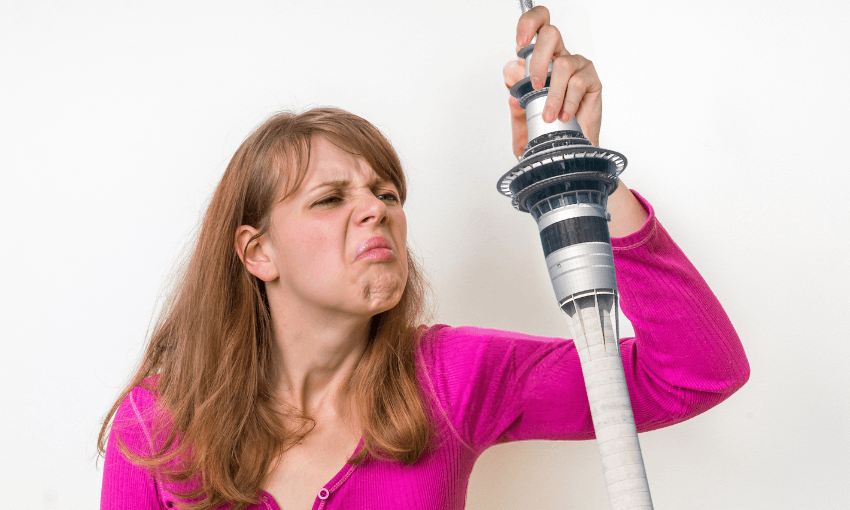If there’s one thing that connects big cities around the globe, it’s that they stink. The biggest city on Māui’s fish in the south seas can finally consider itself big.
I knew it was official when I sauntered along Jellicoe Street in North Wharf downtown one evening. Each time I passed a storm drain, I felt like vomiting. Out of them pulsed a stench that was heavy, fetid, sweet and poopy. Finally, I thought. We’re a proper big city.
Other people have noticed the stinks too. Queen street smelled like rats’ carcasses according to a Tripadvisor review from January, and the central city has recently been said to smell like:
- dick, balls and arse
- hot tar and piss
- boiled cabbage
- a rubbish tip
- leaking sewage
- the smell of rising rates
- rotten meat
- poo
- urine and ammonia
Aucklanders – before you get offended, consider that these descriptors could just as aptly be describing New York, London, Paris or Seoul, those glittering cities on postcards and in movies that have functioning public transport systems and restaurants that stay open after 7pm. Smell has for too long been overlooked as a detector of achievement. Consider it a compliment.
The stink, I think, is a patina. The grime – pollution, trash, last night’s alcohol, sewage, piss, coffee, animals, food being cooked, strangers’ perfumes, and whatever Miss Higgins emits – has to accumulate over time, and seep into the pores of the city to then delicately mix the different notes of odour into a city stink. I would say it can’t be faked, apart from last year a scentsmith pretty successfully captured Karangahape Road in a nice little bottle. Still, those nasty wafts are badges of honour acquired through hard work and time.
Those who know more about history than I did a few days ago will be smiling right now. They can’t wait to get to the comments and tell me Auckland has a very stinky history, actually. But I too have the internet. In 1870 the city smelled straight up “evil” according to the New Zealand Herald. Sewage was everywhere – “the want of sewers causes surface water to lie in the streets, forming long lines of festering matter, giving out noxious and health-destroying gases. Garbage lies about and evil smells rise to warn the passer by of decomposition, of foul atmosphere injurious to breathe”.
There was one open sewer, The Ligar Canal, which had a track running down its eastern side (now Queen Street). It was known as the Waihorotiu Stream until 1852, when enough waste had been dumped into it that it was an olfactory menace. By 1870 it was “a pestiferous ditch, the receptacle of every imaginable filth, bubbling in the noon day sun”. In the suburbs people dug holes, known as cesspits, and hoped the sewage wouldn’t leak out (it did) or, they put it in pans to be collected by night-soil men. Disposal of this night-soil was questionable.
That same year a “new chum” in The Daily Southern Cross wanted the city fathers fired because they did “not open [their] purse-strings… to resolve the issue of sewage disposal.” He wanted to get rid of them all and “exercise a sort of dictatorship” where he would revolutionise the streets, sorting out the stinky problem in just six months. Improvements were being made to the canal in the 1860s, and it was eventually covered in the 1870s, becoming the Queen Street sewer we know today, a brick-lined sewer with an oval cross-section. Wastewater treatment began in 1914. For about 90 years, these changes kept the stink of the burgeoning city at bay.
Even before pākehā arrived the Tāmaki Mākaurau area would have stunk in places – the tidal wetlands, the sweet walnutty waft of hangehange, traces of ahi kā burning in the wind. But the smells I’m celebrating today are strictly those of urbanisation.
Now, that sewer stinks, and so do the concrete, asphalt, tiles and air on top of it. Enough humans have graced Auckland with their smelly presence for a little bit of each to rub off, and build up into a nose crinkling, nausea inducing, disgust forming, patinated presence. The city is like an authentic antique, holding its history perceivably.
That evening teenagers played basketball in the courts next to the silos, people milled around a little food market with meat on sticks and the harbour bridge had put on its finest lights. “We live in a society,” I thought to myself, unable to speak since I was holding my breath. I felt a sense of solidarity with the 1,692,999 other inhabitants of the city. Together, we’ve made something beautiful.



